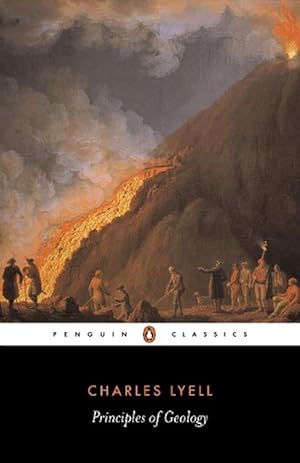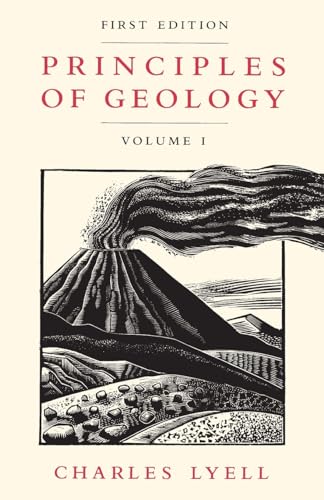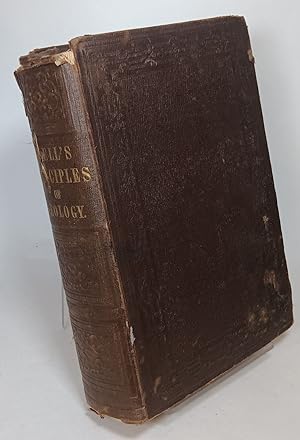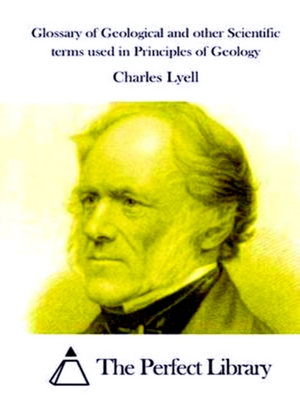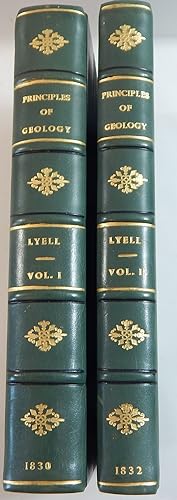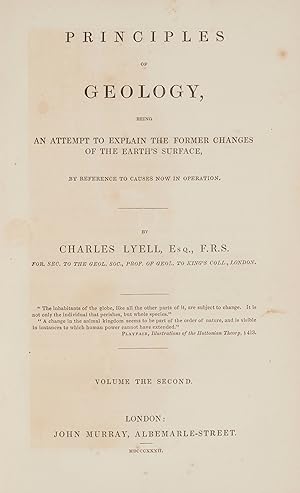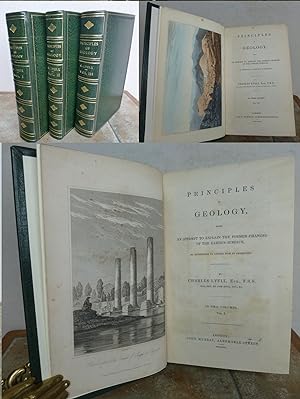Principles Geology by Charles Lyell, First Edition (15 results)
Product Type
- All Product Types
- Books (15)
- Magazines & Periodicals
- Comics
- Sheet Music
- Art, Prints & Posters
- Photographs
- Maps
- Manuscripts & Paper Collectibles
Condition
Binding
Collectible Attributes
Free Shipping
Seller Location
Seller Rating
-
Principles of Geology (Paperback)
Published by Penguin Books Ltd, London, 1997
ISBN 10: 014043528XISBN 13: 9780140435283
Seller: Grand Eagle Retail, Wilmington, DE, U.S.A.
Book First Edition
Paperback. Condition: new. Paperback. One of the key works in the nineteenth-century battle between science and Scripture, Charles Lyell's Principles of Geology (1830-33) sought to explain the geological state of the modern Earth by considering the long-term effects of observable natural phenomena. Written with clarity and a dazzling intellectual passion, it is both a seminal work of modern geology and a compelling precursor to Darwinism, exploring the evidence for radical changes in climate and geography across the ages and speculating on the progressive development of life. A profound influence on Darwin, Principles of Geology also captured the imagination of contemporaries such as Melville, Emerson, Tennyson and George Eliot, transforming science with its depiction of the powerful forces that shape the natural world. Influencing Darwin, Tennyson and Dickens among others, Lyell's "Principles" was an ambitious attempt to forge links between observable causes - volcanoes, earthquakes, rivers, tides and storms - and the current state of the earth. This edition has an introduction by Jim Secord. Shipping may be from multiple locations in the US or from the UK, depending on stock availability.
More buying choices from other sellers on AbeBooks
New offers from US$ 23.49
Also find Softcover First Edition
-
Principles of Geology First Edition Volume I
Published by University of Chicago Press, Chicago, 1990
Seller: Ann Becker, Houston, TX, U.S.A.
First Edition
Paperback. Condition: Very Good. Dust Jacket Condition: No Dust Jacket. First Edition. Bookplate stamp.
-
Principles of Geology, Volume 1
Published by University Of Chicago Press, 1990
ISBN 10: 0226497941ISBN 13: 9780226497945
Seller: Kennys Bookshop and Art Galleries Ltd., Galway, GY, Ireland
Book First Edition
Condition: New. Num Pages: 586 pages, 2 plates, 33 line drawings. BIC Classification: RBG. Category: (P) Professional & Vocational; (UP) Postgraduate, Research & Scholarly; (UU) Undergraduate. Dimension: 215 x 140 x 33. Weight in Grams: 707. . 1990. 1st Edition. Paperback. . . . .
-
Principles of Geology: The Modern Changes of the Earth and Its Inhabitants
Published by Little, Brown, Boston, 1853
First Edition
HARDCOVER. Condition: Poor. 1st edition. Rear cover detached, backstrip is flapping and held on by one edge, heavy wear and soiling to the boards, foxing throughout, fold-out maps, b/w ill.
-
Glossary of Geological and other Scientific terms used in Principles of Geology
Published by Createspace Independent Publishing Platform, 2015
ISBN 10: 1522872868ISBN 13: 9781522872863
Seller: Collectors' Bookstore, Antwerpen, Belgium
Book First Edition
Paperback. Condition: Fine. First Edition. First Edition thus. Glossary of Geological and other Scientific terms used in Principles of Geology by Charles Lyell. Published by Createspace Independent Publishing Platform in 2015. Paperback ISBN:9781522872863. Collectible item in very fine condition.
-
Principles of Geology: Being an Inquiry how far the Former Changes of the Earth's Surface are Referable to Causes now in Operation. Volume 2
Published by Kay James Philadelphia, 1837
Seller: Antique Emporium, Eau Claire, WI, U.S.A.
Book First Edition
Hardcover. Condition: Good. No Jacket. 1st Edition. 4to hardcover volume in brown cloth.Wear to spine and some splitting to the spine cloth. Boards nice and tight some wear to edges and a stain on front board. End paper good with pencil names. 553 pages with scattered foxing. 2 foldout plates good and one color plate with other plates.1st American edition.
-
Condition: Good. Philadelphia: James Kay, Jun. & Brother, 1837. 1st American edition, from the 5th London ed. Volume 2. Sm 4to. 553pp. Illus., plates, some folding, some color, maps. Good book. In original publisher's binding. Spine sunned. Owner's name embossed on front free endpage. Some foxing. (geology) Inquire if you need further information.
-
Principles of Geology; or, The Modern Changes of the Earth and its Inhabitants, considered as illustrative of Geology. By Sir Charles Lyell, M.A. F.R.S.
Published by London: John Murray Albermarle Street, 1850
First Edition
"Eighth And Entirely Revised Edition." A very good original binding with all engravings. Thick 8vo. 22.9cm x 15.2cm x 5.9cm. pp.16/pp.811/[1p. - Colophon]. + 12 plates (some folding) . Publisher's original green cloth binding. Gilt image to front board and gilt titles to spine. Edges rubbed and bumped. Spine sunned. Top & tail of spine carefully strengthened. Original yellow endpapers. Engraved armorial bookplate to verso of the front board: "Fothergill". Modern armorial bookplate to front endpaper with motto: "Usque Ad Finem". Engravings lightly foxed, with some off-setting to pages adjacent to the plates, otherwise clean text throughout, with just the odd brown spot. Illustrated throughout with numerous engravings within the text. A very good book. ** Sir Charles Lyell was a geologist whose work helped to found the modern notion of geology and geologic time whilst establishing geology as a seperate science. In his first book, Principles of Geology, (1830) he propounded his theory of uniformitarianism, that the Earth's history can be explained by gradual change over time. He also proposed the idea that different periods of geologic time could be established by reference fossils, he divided geologic time into four periods; Pleistoscene, Older Pliocene, Miocene and Eocene. He also expounded notions on the rock cycle, how one type of rock was transformed into another, volcanic forces, deposition and erosion. Lyell attended William Buckland's (1784-1856) lectures on Geology in1818. He visited Paris in 1823 where he spent 2 months. The scientific influence of Paris was profound for Lyell. He first became aware of the depth and seriousness of French studies on natural history and geology.In 1822 Lyell was called to the bar; and from 1825-1827 he was a practicing barrister. Whilst on circuit he had the opportunity to study the geology of the Southwest of England. In May 1828 he travelled to Europe (some of the journey with Sir Roderick Impey Murchison 1792-1871) going through France and into Italy. In 1830 he made a geological journey to the Pyrenees. In the first edition of his Principles of Geology, (1831) Lyell argued that the natural order of the past was uniform with that of the present; the same physical laws held true and the same kinds of processes occurred. The geologist should, therefore, attempt to explain geological phenomena by analogy with modern processes. The doctrine came to be known as uniformitarianism. Lyell continued to revise Principles of Geology throughout his lifetime and brought out 12 successive editions. He later published Elements of Geology, (1838) in one volume. This first modern textbook of geology assumed that geological phenomena could be explained completely in terms of natural and knowable causes. He developed a warm friendship with Charles Robert Darwin (1809-1882) in 1836, shortly after Darwin's return from the 'Beagle' Voyage. Lyell's theoretical positions even when wrong, were always carefully reasoned; and he showed an extraordinary capacity even into old age to understand the meaning of new evidence and to change his mind. See NAHSTE project.
-
Principles of Geology; or, The Modern Changes of the Earth and Its Inhabitants
Published by John Murray Publishers Ltd, London, 1853
Seller: PsychoBabel & Skoob Books, Didcot, Oxfordshire, OXON, United Kingdom
First Edition
leather. Condition: Very Good. Ninth Edition. Hardcover fully bound in soft tan leather with marbled page block and marbled endpapers. Revised ninth edition with maps, plates and woodcuts. Spine piece is quite worn and has come away from the binding. Board corners and edges also worn. Light foxing to a few internal pages, signatures of two previous owner's to FEP. Internal contents remain in very good condition, text, fold-outs and illustrations are clean and clear. AD. Used.
-
Hardcover. Condition: Near fine. First edition. 2 volumes 8vo. Illustrated. Engraved frontispieces, the frontispiece of volume two hand-colored. Half leather, spines in six compartments with raised bands, gilt. The frontispiece of volume one is foxed else this is a near fine set. In spite of the note on volume one that this is in two volumes, a third volume was later issued in 1833, not here present. .
-
Principles of Geology: Being an Attempt to Explain the Former Changes of the Earth's Surface, by Reference to Causes now in Operation
Published by John Murray, London, 1832
Seller: Hordern House Rare Books, Surry Hills, NSW, Australia
First Edition
Three volumes, octavo, with a total of 11 plates, two of which are hand-coloured frontispieces, and including three maps, two of which are folding and two coloured; without the half-title in vol. 3, not called for in other volumes; bound in later plain calf, flat spines banded and numbered in gilt, red leather labels. A good early set of this classic by 'the father of modern geology', composed of the second edition of the first volume, and first editions of the other two volumes. Principles of Geology "has been called the most important scientific book ever. [it] shook prevailing views of how the earth had been formed" (Cambridge). "One of the key works in the nineteenth century encounters between science and Scripture, Charles Lyell's Principles of Geology sought to explain the geological state of the modern Earth by considering the long-term effects of observable natural phenomena. Written with clarity and a dazzling intellectual passion, it is both a seminal work of modern geology and a compelling precursor to Darwinism, speculating on radical changes in climate and geography across the ages, and exploring the evidence for the progressive development of life" (Secord). The second edition of the first volume was the edition in print when the second volume appeared. Just 1500 copies had been published of the first volume in 1830: no one had anticipated the immediate success of the revolutionary book: eleven editions would eventually appear during Lyell's lifetime, and at the time of his death he had just finished his revisions for the first volume of the 12th edition. The book was to have a fundamental effect on the development of Darwin's thinking. "When the Beagle expedition sailed in 1831 Henslow presented Darwin with the first volume of Lyell's Principles of Geology . The second volume of Lyell's book reached Darwin in Montevideo and his constant references to the enormous influence on his thinking of this great work are typified by a letter from him to Leonard Horner saying 'I always feel as if my books came half out of Lyell's brain'" (PMM). Darwin openly acknowledged that Lyell's identification of changes operating over huge periods of time to create geological features was part of the key to his development of the theory of natural selection. He remarked that 'The great merit of the Principles was that it altered the whole of one's mind, & therefore that, when seeing a thing never seen by Lyell, one yet partially saw it through his eyes'. 'Charles Lyell's Principles of Geology shaped Darwin's vision of nature as he circumnavigated the globe on the Beagle and as he later created his theory of evolution . Darwin became his most enthusiastic advocate, and found the Principles immensely liberating from the moment of landing on his first tropical island during the Beagle voyage. The young naturalist used the book to develop his own causally-oriented style of interpretation, comparing the uplifted but scarcely disrupted rocks in the mid-Atlantic Cape Verde Islands with the Temple of Serapis. Later in the voyage he reinterpreted the origin of coral reefs, overturning the model that Lyell had advocated; but the style of reasoning was that of the master, who altered his next edition accordingly. When Darwin began to consider the possibility of species evolution after his return home, he did so in private dialogues with the Principles." (Secord, pp. ix & xxxvi). Collation: I: pp. xvi, 586 (as against 511 pp in the first edition); II: pp. xii, 330; III: pp. [iii] (title)-xxxii, 398, 109 [1] (adverts.). There are different states and issues of the first editions involving the state of the publisher's advertisements and by the presence or absence of a colophon leaf in volume 2. There is no separate final leaf (Z2) in volume 2, which in copies that have the leaf is used only for the printer's details as a colophon. Most copies of volume 2 including ours do not include advertisements, but a copy recently described by a colleague had.
-
PRINCIPLES OF GEOLOGY Being an Attempt to Explain the Former Changes of the Earth's Surface by Reference to Causes Now in Operation. Signed.
Published by London John Murray, 1830
Book First Edition Signed
Hardcover. Condition: Very Good. 1st Edition. 3 VOLUMES, COMPLETE SET, FIRST EDITIONS 1830-1833, PRESENTATION SET to "W(illiam) L(onsdale) (geologist, see below) from the author" inscribed on half-title of Volume I and "Lieut. Lonsdale from the author" on front endpaper to Volume II (see attached images). The signature on Volume 1 is either in a secretary's hand or Lonsdale's, but the signature on Volume 2 is in Lyell's hand. Mixed set, Volume 3 from another set and slightly trimmed. 8vos, approximately 215 x 135 mm, 8½ x 5½ inches, VOLUME 1: engraved frontispiece, 2 maps, 1 folding, 1 half page, 1 half page engraved view and 33 text illustrations; VOLUME 2: hand coloured aquatint frontispiece, folding hand coloured map, 8 text illustrations; VOLUME 3: Hand coloured frontispiece, 4 engraved plates, coloured map, 88 text illustrations, pages: Volume 1, xvi, [1]-511 including index plus 17 page Murray catalogue dated June 1830; Volume 2, xii, [1]-330, including index plus 16 page catalogue dated December 1831, Volume 3, xxxi plus Errata, [1]-398, [1]-110 - Appendix, Glossary and Index, last page publisher's adverts, half-title in Volume 1, not called for in Volume 2, Volume 3 lacks half-title. Handsomely bound in modern green full morocco, single gilt ruled border with inset blind stamped border, gilt raised bands to spines, 5 gilt framed compartments with gilt motif, gilt lettering, new endpapers. Frontispiece in Volume 1 lightly spotted, plate 3 with 2 images lightly browned and slighly foxed, light offsetting on page 1 from folding map in Volume 2, Volume 3, frontispiece has fox spot to 1 margin, plate and maps have pale foxing, very occasional small pale mark to margins in all volumes, otherwise very good clean tight set. This work has been called the most important scientific book ever. A stunning claim, but certainly Charles Lyell's Principles of Geology, published in 1830, shook prevailing views of how Earth had been formed. His book was an attack on the common belief among geologists and Christians that unique catastrophes or supernatural events -- such as Noah's flood -- shaped Earth's surface. Lyell argued that the formation of Earth's crust took place through countless smaller changes occurring over long periods of time, all according to known natural laws. His proposal was that the forces shaping the planet have operated continuously throughout its history. He also wrongly assumed that these causes must have acted only with the same intensities now observed, which would rule out asteroid impacts and the like. Darwin read Lyell's landmark text while on the Voyage of the Beagle, and was much inspired by it. His own experiences during the voyage backed up Lyell's theories of how the shifting crust of the Earth was one of these long-acting, gradual, shaping forces. See Printing and the Mind of Man, page 208, Chapter on The Theory of Evolution, No. 344; Dibner Library, Heralds of Science, revised edition, page 46, No.96. William Lonsdale (1794-1871) became a serious geologist and palaeontologist after a career in the army which ended in 1829. He wrote several papers on fossils and won the Wollaston medal in 1846 for his research on the various kinds of fossil corals. THE GEOLOGY OF RUSSIA IN EUROPE AND THE URAL MOUNTAINS by Roderick Impey Murchison, with Appendix with articles by various authors the longest being Palaeozoic Corals of Russia by W. LONSDALE, Vol.1. MORE IMAGES ATTACHED TO THIS LISTING, ALL ZOOMABLE, FURTHER IMAGES ON REQUEST. POSTAGE AT COST. Signed by Author(s).
-
The Principles of Geology: Being an Attempt to Explain the Former Changes of the Earth's Surface, by Reference to Causes now in Operation. Three vols
Published by John Murray, London, 1833
First Edition
First edition. EVANS 68 - ONE OF THE GREAT CLASSICS OF GEOLOGY. First edition of this "classic by 'the father of modern geology'" (Grolier/Horblit), famous for "establishing a new era in geology" (DSB), presenting the doctrine of uniformitarianism, namely, that the processes of the past must be judged by those of the present. "One of the key works in the nineteenth century encounters between science and Scripture, Charles Lyell's Principles of Geology (1830-33) sought to explain the geological state of the modern Earth by considering the long-term effects of observable natural phenomena. Written with clarity and a dazzling intellectual passion, it is both a seminal work of modern geology and a compelling precursor to Darwinism, speculating on radical changes in climate and geography across the ages, and exploring the evidence for the progressive development of life" (Secord). "Principles still recalled Isaac Newton's Principia and the subtitle stated clearly that it was 'an attempt to explain the former changes of the earth's surface, by reference to causes now in operation' . [Lyell's] main source was the great compilation of the physical and topographical changes recorded within human history, published in 1822-4 by Karl von Hoff (1771-1837). He used Hoff's data to illustrate his own view of the earth as a system of balanced antagonistic processes: erosion balanced by sedimentation, for example, and crustal elevation by crustal subsidence. A preliminary section of the book presented a 'grand new theory of climate' (Lyell, Life, I, p. 261), which interpreted long-term climatic changes as the products of an ever-changing physical geography" (ODNB). This was the work that, more than any other, prepared the way for Darwin's Origin. Darwin acknowledged that Lyell's explanation of geological features by causes operating over immense periods of time was part of the key to his development of the theory of natural selection. "When the Beagle expedition sailed in 1831 [John] Henslow [Darwin's mentor] presented Darwin with the first volume of Lyell's Principles of Geology . The second volume of Lyell's book reached Darwin in Montevideo and his constant references to the enormous influence on his thinking of this great work are typified by a letter from him to Leonard Horner saying 'I always feel as if my books came half out of Lyell's brain'" (PMM). When Alfred Russel Wallace sent Darwin a letter in 1858 outlining an almost identical theory to his own, it was Lyell, together with Joseph Hooker, who engineered the simultaneous publication of papers by both men, and secured Darwin's claim to the theory of 'natural selection.' Only two other copes in the original boards have appeared at auction, both of which were rebacked with new spine labels. Many geologists of his day, including Cuvier and others, believed that the Earth had been shaped by cataclysmic events in the past unparalleled in modern times. Lyell argued, on the contrary, that the order of nature in the past was uniform with that in the present, and that therefore all geological phenomena should be attributed to the gradual action, over sufficient time, of modern geological processes. This hypothesis led to one of the most revolutionary scientific ideas of the nineteenth century - that the age of the earth was enormously greater than had previously been supposed. To demonstrate that gradual processes could be responsible for great changes, Lyell used an engraving of the temple at Serapis as his frontispiece. The temple had, during the course of human history, been above sea level, then for a long period partially submerged, and again was above sea level as attested by the dark bands of damage caused by waterborne life across the columns. "'The great merit of the Principles,' Charles Darwin once said, 'was that it altered the whole of one's mind, & therefore that, when seeing a thing never seen by Lyell, one yet partially saw it through his eyes,' Charles Lyell's Principles of Geology shaped.


